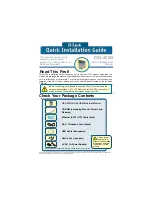
Weidmuller Wireless Ethernet Modem & Device Server WI-MOD-E-G/A User Manual
Rev.
2.16
www.weidmuller.com
20
3.1 - Selecting a Channel
802.11b/g (2.4GHz)
The WI-MOD-E-G conforms to the IEEE 802.11b/g Wireless LAN specification. The WI-MOD-E-G supports 13 x 20MHz,
12 x 10MHz and 13 x 5MHz radio channels in the 2412MHz to 2482MHz frequency range. Channels are country or region
specific. Please check your local regulatory body for compliance and channel selection.
You can see from the diagram below there are a limited number of channels available in the 2.4 GHz frequency range.
Care must be taken when selecting an operating channel as some of the channels overlap.
The 20M channels have a separation of 5MHz which means there is some overlap into the
next channel, i.e. channel 1 will overlap into channel 2, 3 and 4; channel 6 will overlap into
channels 3, 4, 5, 7, 8 and 9. If complete separation is required then you can use channels 1,
6 and 11 without any interference between the channels.
The 10M channels are also separated by 5MHz and overlap the adjacent channels by 5MHz
forward and backward, i.e. Channel 41 will overlap with channel 42; channel 46 will overlap
with channel 45 and 47.
Lastly the 5MHz channels are separated by 5MHz and do not overlap at all so you can operate all 13 channels at the
same time with minimal interference with the adjacent channel.
Only one of these channels is used at a time and is configured at the Access Point, The Access Point then uses this
channel to send out beacon transmissions and connections.
Clients scan all channels for a suitable Access Point and then adopt the same channel as the AP when a connection is
established.
The following diagram shows the RF energy distribution for the 802.11b/g transmission:
On the 20MHz channel (Green) most of the energy is transmitted within the channel however some of the energy is
transmitted on the channels either side therefore causing interference on the these channels. The 10MHz channels
(Orange) are similar with half of the energy overlapping into the next channel however you can configure up to 6 x non
interfering channel at the one time. Lastly the 5 MHz channels (Blue) do not overlap and so all 13 channels can be used
at the same time.
There is also a single 40MHz Channel (Purple) which takes up over half of the full 2.4 GHz band and so it much more
susceptible to interference from other channels.
If there is more than one 802.11 AP within the same wireless range, then it is important that the AP’s are on channels as
far apart as possible.
If there are two 20MHz channel AP’s, then set them to channel 1 and 11. If there are three, set them to 1, 6, and 11.
11
6
1
11
1
6
11
1
6
Figure 11 - 2.4GHz Frequencies
Figure 10 - Channel
Separation
















































